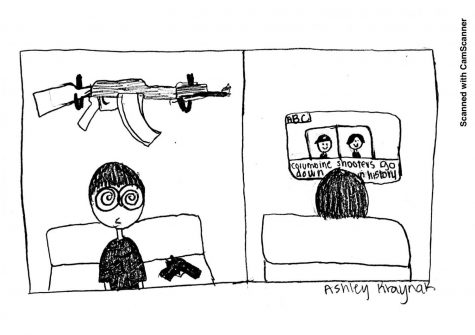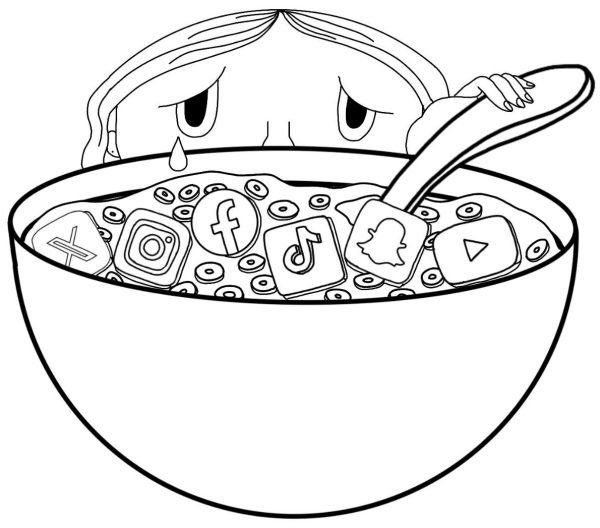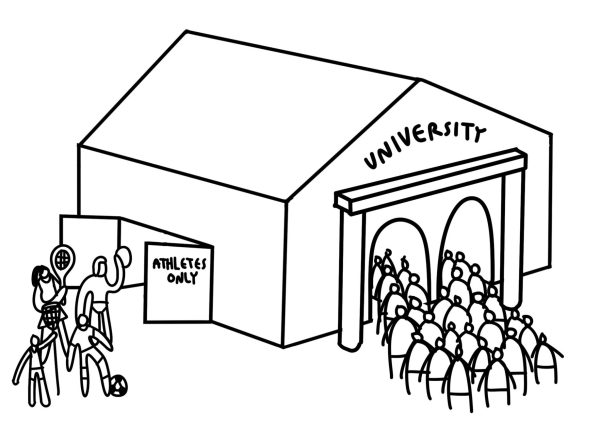Giving mass murderers media coverage is only providing the attention they crave
April 4, 2019
“I’m Andrew Cunanan. I’m a serial killer,” Darren Criss said as season one, episode two of “American Crime Story: the Assassination of Gianni Versace” came to a close. Criss recently portrayed notorious murderer Cunanan in the Netflix television series. In 1997, Cunanan went on a killing spree, which included the murder of fashion icon, Gianni Versace. The series highlights the ups and downs of Cunanan’s life, including his upbringing and struggles with his sexuality. The story is provocative, dramatic and exciting. That is, to a stable-minded individual whose is only watching out of pure curiosity for a significant moment in history. However, some impressionable minds, and others who already committed a crime, may have a different take.
Putting a media spotlight on mass murderers is only giving them the attention they desperately crave. Digging into their past and letting their name reach top headlines pushes them towards notoriety. Trying to unmask the motives for their crime, such as mentioning an unstable childhood or revealing that they had been bullied at school, is a form of glorification. Not only does it give them excuses, but it fuels their desire to go down in history for their crimes. This is a dangerous mindset, and a campaign called No Notoriety plans to do something about it. They recognize that the prospect of infamy serves as a motivating factor for other individuals to kill and inspires copycat crimes. Their slogan is “No Name. No Photo. #NoNotoriety”. In the instance of a tragedy, the media must report on it responsibly for the sake of public safety, and in doing so must deprive violent-minded people a celebrity status.
Despite these precautions, the media turns its focus on the perpetrators of school and other mass shootings more often than not. In doing so they risk putting the criminal on a pedestal in front of the general public. This was especially evident with the 1999 Columbine High School shooting. The two perpetrators, Eric Harris and Dylan Klebold, were explicitly seeking fame, and they received it due to excessive news coverage of the event. Nearly 20 years after the fatal day, the criminals have amassed a cult following known as the “Columbiners.” The crime has inspired several copycats; other school shooters have referred to them by name in manifestos they have left behind. “Columbine” has become a byword for a school shooting.
On Feb. 14, 2018, Nikolas Cruz opened fire inside Stoneman Douglas High School. This horrendous act remains the deadliest shooting at a high school in United States history and afterward the world was outraged, and rightly so. However, headlines featuring Cruz described him as a “troubled kid,” significantly downplaying and disregarding the gruesomeness of his crimes. Around 9,650,000 results pop up when you Google his name and it remained top news for weeks after the incident. Less than a month after the shooting, Cruz had received stacks of fan mail and love letters sent to where he was being held at the Broward County jail. The media greatly mishandled the situation by letting the murderer’s face spread everywhere. Students at Stoneman Douglas High School were left with suffering from everything from PTSD and survivor’s guilt. Two Parkland survivors, 16-year-old Calvin Desir and 19-year-old Sydney Aiello have both committed suicide in the past week. This is all while Nikolas Cruz will live down in infamy.
Many serial killers actually seek out public notoriety and actively engage in the creation of their public image. One example is Los Angeles serial killer Richard Ramirez, dubbed the “Night Stalker” by the press. As his personal signature, Ramirez would draw symbols on the walls of each crime scene, such as an inverted pentagram with his victim’s lipstick. Ramirez left the city and the rest of the world in a state of terror. Even in death, the Night Stalker remains one of the most notorious serial killers of all time. Ramirez took pride in the fame of being a murderer, and the surplus of press coverage and speculations only encouraged him to continue.
Criminals receiving the wrong kind of attention is not a new problem. A group of so-called “Bundyphiles” sent bags of mail to Ted Bundy, the serial rapist-murderer who was electrocuted on Florida’s Death Row in 1989. These included declarations of love and photographs from fans, all while he was on trial for the gruesome murders of 36 women. Fans even took to flocking the courthouse, proclaiming his innocence. Bundy’s reported good looks and charisma drew fans in and lead them to take no account of the evils he had committed and the women he had killed. Many were too lost in the fact that he didn’t look or act like a killer in his daily life, and in the meantime the media focused more on his shocking good looks than his crimes. Even in death, Bundy remained one of the most notorious serial killers of all time. A recent documentary series called “Conversations with a Killer: the Ted Bundy Tapes” has been released on Netflix, and has been receiving growing popularity with our community and the world. Bundy lives on, and not in the most ideal way.
When a tragic crime occurs, the most ethical and respectful way for the media to approach it is to focus on the victims. As soon as the news outlets report on the criminal’s life, they are giving them exactly what they want. Criminals thrive in the limelight of front-page news and headlines. Some love it to the point where they risk spending the rest of their life in prison with possibility of death penalty, as they crave the spotlight and infamy that comes along with being a criminal.
Media has the power to affect our mindsets on a large scale. This power can be abused very easily, as it has been time and time again by news outlets in the wake of the worst of crimes. Giving serial killers and mass murderers even a minute of media attention does nothing but inflate their ego and fuel their hunger for more fame.






















